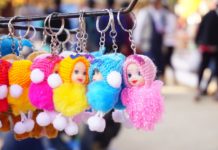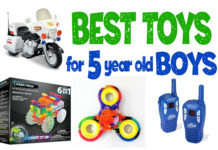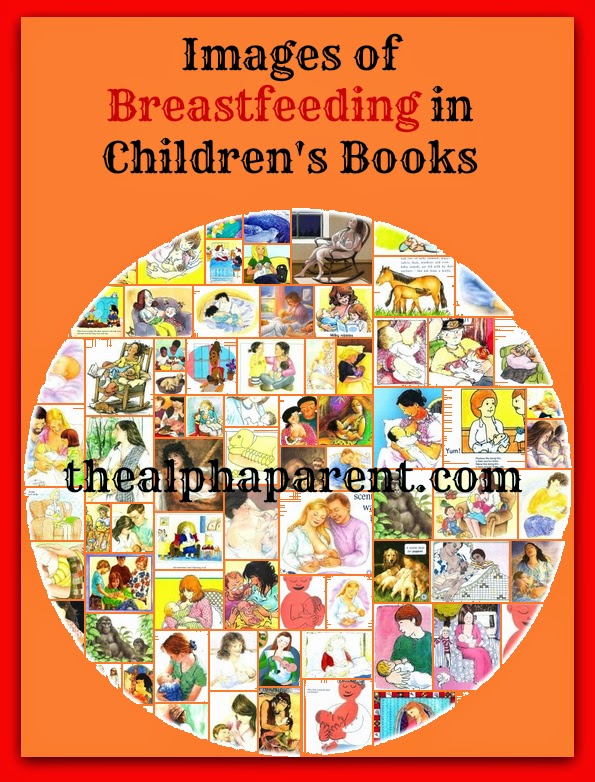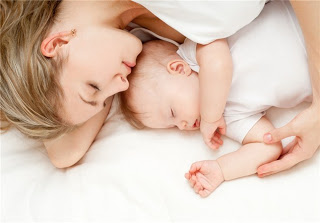(Catch up with Part One, Part Two, Part Three, Part Four and Part Five).
The Body Book
Claire Rayner
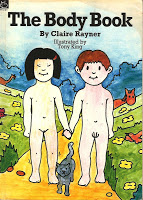
This is an epic review for an epic book. I grew up with this book in the 80s and have fond, pervy memories of it. I say ‘pervy’ because it features copulation is all its glory. I’m talking full-on penetration including an erect penis that would make John Holmes blush. As a child I felt devilishly naughty looking through its pages and would take great pride in ‘shocking’ my friends with the contents. The characters have cheesy 70s hairdos and facial hair, as well as a reluctance to use anatomically correct terms. For instance, a vagina is a ‘baby-making place’, an anus is a ‘little hole’, testacies are ‘little round balls’, and yet curiously a penis is still called a penis. The book covers all aspects of the human body, from boring aspects such as the skeleton, muscles and blood cells, to yucky aspects like bodily excretions and farts, and then of course the interesting well-thumbed part of the book: “Growing and Changing and Making New People”. In this chapter a conservative text explains that: “When a man and a woman want to make a baby, the man’s penis stops being floppy and stands to attention”. We are promptly treated to a close-up illustration of a penis saluting.
After the usual timeline of pregnancy, the process of birth is depicted vaguely and somewhat bizarrely: “It is hard work for a mother to help her baby get out. She has to stretch her baby-making place very wide, and that takes a lot of time. But it is worth the hard work, because a new baby is a very happy person to have in a family”. Is the stretching referring to the vagina or cervix? We will never know as this book seems to have a fear of reproductive terminology. Also the assumption that ‘a baby is a very happy person to have in a family’ is amusingly nonsensical considering how much of a baby’s first year it spends crying.
After birth the book features a brief nod to breastfeeding. The text describes that: “After the baby is born, his mother holds him close to her breasts and puts the soft tip of one of them in his mouth. Then he can suck, and get the milk the breasts are making”. Although the word ‘breast’ is used correctly, there’s no mention that ‘the soft tip’ is called a nipple. Refreshingly however the mutual pleasure of breastfeeding is described: “Mothers like doing this. It feels nice for them. Babies like doing this. It feels nice for them, too”. Also skin to skin is championed: “Breasts are for making milk to feed the baby with. They are also to help cuddle the baby. Being cuddled by a mother with warm soft breasts is very nice for babies and children”. In all I would recommend this book for its nostalgic quirky value.

The Bare Naked Book
Kathy Stinson
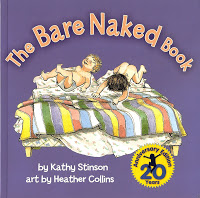
Each page in this bubbly light-hearted book focuses on a different body part. Hair, eyes, nose, shoulders, tongue, and so on. It acts as a charming introduction to the human body for inquisitive toddlers. The text is shy on detail so as not to be overbearing, and serves as a simple bedfellow for the stunning illustrations. For instance, on the page titled ‘Hair’ the detailed illustration shows a bustling family in their bathroom. The text simply and eloquently reads: “Dripping hair. Straight hair. Tangled hair. Curly hair. Where is your hair?” Unlike ‘The Body Book’ (reviewed above), this book features the correct anatomical labels for each body part (including penis and vagina). On the page titled ‘Nipples’ the text reads: “Little nipples. Hairy nipples. Milky nipples.” An accompanying illustration shows a multitasking mother breastfeeding her infant whilst reading with an older child. A miscellany of body shapes are celebrated throughout the book – double chins, mutton tops, fat rolls, short people, tall people, old people, and of course, children. However for a book that purports to “play tribute to the wonderful diversity of our marvellous bodies” there is one flaw – everyone is white.

When I Was a Baby
Catherine Anholt

From the same author-illustrator that brought us ‘Sophie and the New Baby’ and ‘Aren’t You Lucky’ (both reviewed in Part One) here is another story featuring a young girl learning about babies. The familiar felt-tipped illustrations that Catherine Anholt is famous for are plentiful, however this time, instead of preparing for the arrival of a new sibling, the little girl is reflecting on her own babyhood. Together with her Mum, they discuss the various milestones of her infancy, starting with her arrival home from hospital, then discussing babycare tasks such as bathing and nappy changing, and ending with her first birthday party. There is an eclectic mix of parenting styles depicted in the book. Breastfeeding and cosleeping are shown at the start. An illustration shows Mum nursing her daughter in bed, with moses basket close by, whilst Dad delivers breakfast to them. In the accompanying text the little girl asks “What did I eat when I was a baby?” to which her mother responds: “For a long while you only drank milk”. No more is said regarding breastfeeding and later in the book a bottle is shown. There is no babywearing. Instead the baby is transported in a pram. However the baby does appear to be wearing cloth nappies rather than disposables, and babyled weaning is hinted at. So as I said, an eclectic mix.
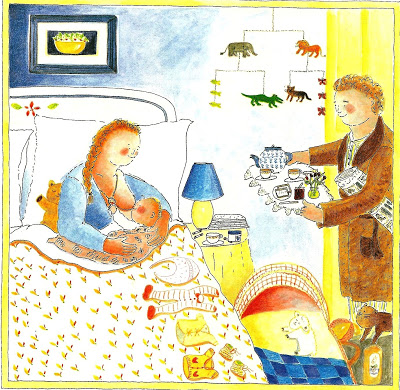
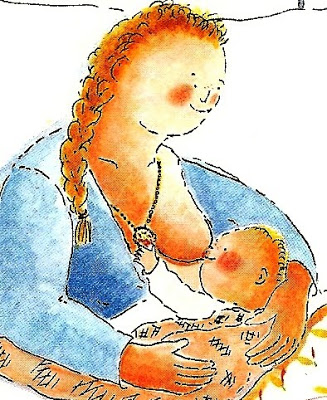
Hello Benny!
Robie Harris
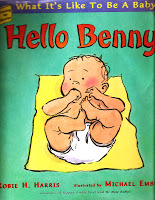
I dislike this book. Why would I dislike a book which features breastfeeding and was created by the same author who brought us the pro-breastfeeding books ‘Happy Birth Day!’ and ‘Hi New Baby!’ (reviewed in Part Four) you may be wondering. I dislike this book because of the clumsy way it describes breast milk and formula. After announcing the birth of baby Benny the text inform us that: “The only food new babies need is milk from their mother’s breasts or from a bottle filled with special milk for babies. This special milk is made from cow’s milk or soybeans. Breast milk and the special milk taste different from the milk we drink. The special milk has a stronger taste because extra vitamins, salt, sugar, and fat have been added to it”. Firstly, why use the word ‘special’ to describe formula? Why not just call it formula? Secondly, why mention that ‘special milk’ has vitamins added but neglect to mention that breast milk already contains those vitamins and a host more? None of the attributes of breast milk are mentioned. These oversights are a real shame considering that the book contains a wonderful full-page illustration of a happy mother nursing her newborn with proud father on looking.

Farmyard Hullabaloo
Giles Andreae and David Wojtowycz

Farmyard Hullabaloo ticks all the boxes of a great book for toddlers. Simple illustrations? Check. Lots of primary colours? Check. Bubbly rhyming text? Check. Animals? Check. Each page describes the life of a different farm animal from their own perspective – and that perspective can be bluntly honest at times. For instance, the rather menacing-looking fox says, “I wait in the woods until nightfall, Then down to the farmyard I creep, Because nothing looks quite as delicious, As chickens who’ve fallen asleep”. The fox is shown stalking around the dark farmyard, licking his lips in anticipation. The best part of the book (not that I’m biased) features a plump cuddly mother pig watching contently as her piglets search for a teat, piling on top of each other like a rugby scrum. A lot of books in the farm animal genre feature pigs nursing their young, but in my opinion none of them do it as endearing as this. The little fatty butts wriggling, the piglet on the right nuzzling its mother’s face adorningly, even the little fella in the corner who is waiting for a teat with a disappointed expression on his little piggy face.
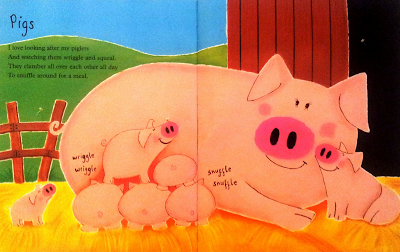
Little Baa
Kim Lewis

Yes I know, it’s another book from the farm genre, and some people have issues with linking farm animals with lactating women; but you know what, we’re all mammals. That fact is to be embraced. Little Baa is a simple yet deeply tender story about a baby lamb and its mother becoming separated. The bulk of the book follows the mother as she desperately tries to locate her baby. She could not see her baby’s spotty ears. She couldn’t smell his familiar smell or hear his little baa. She searches frantically sniffing amongst other lambs but, “None of them were her very own the way Little Baa was hers”. The poor mother, now childless, is rejected by the other mothers. The atmospheric illustrations and endearing narrative capture her desperation at losing her lamb: “The sun was starting to go down. Her voice became a lonely sound. She couldn’t rest or eat or think”. But wait, don’t reach for the Kleenex just yet folks, this is a kiddies book remember. The climax of the story brings with it a tearful reunion between mother and baby. The illustration shows a shaken yet relieved baby lamb nursing, snuggled in his mother’s warmth. “Ma” said Little Baa sleepy. “Are you still there?” “I am, Little Baa, I’m here” said Ma, lying quietly beside him.
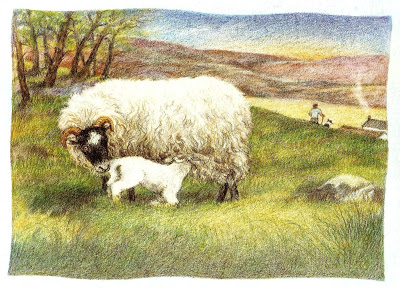
Fast Food for Ben
Ruth Brodbeck
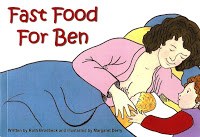
This book, written by a paediatric nurse, midwife and lactation consultant, follows a baby’s breastfeeding journey from birth to six weeks old. The premise is a familiar one – a little girl called Hana adapts to the rival of her new baby sibling. The story features all the elements you’d expect, including a supportive grandma, new mother lounging her in pyjamas, father bathing the baby, relatives visiting, and so on. Interestingly a midwife takes a central role visiting the new baby at home and then weighing him when he is older. The narrative is factual and non-patronising with an appropriate level of depth: “Ben’s tummy is only very small so he needs lots of feeding”. Babywearing and extended breastfeeding are featured prominently. In one scene, an older child of at least toddler age is shown lifting his mother’s top for a feed. This is refreshing to see, particularly as the scene takes place in a public setting around a dinner table with friends and relatives. Another of my favourite parts features Hana playing with her friend. “Mum gives baby Ben fast food from her breasts” she explains as she wears a doll in a sling. Another illustration shows Hana breastfeeding a doll whilst her mother breastfeeds Ben. The retro-style felt-tipped drawings are a wash with primary colours. There are plenty of details to discuss, such as a cat nursing her kittens on the kitchen floor. Some of the illustrations are a little amateurish, for instance in a few of them, pencil sketch outlines have not been rubbed out and the characters’ fingers are often misshapen. However in one sense, this adds a childlike quality to the meaningful text.

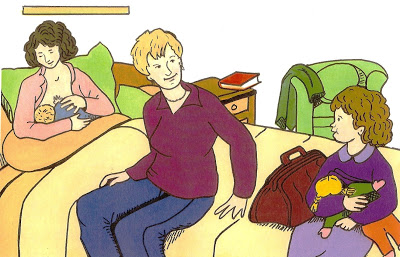


Nursies When the Sun Shines
Katherine Havener

Here is a book of exquisite quality. First to catch the eye is the stunning watercolour illustrations. The soft pastel colours beautifully depict a peaceful night time scene. Graceful shadows linger around a bedroom. A moon glows softly through the clouds casting gentle light onto the bedroom walls. “Baby, sweet baby, it’s sleepy time” begins the text, as we watch a cosleeping family settle down for the night. Mum, Dad and toddler snuggle in the family bed as a cat slumbers at the foot. A perfect scene for breastfeeding right? However there’s no breastfeeding until morning for this toddler, because this book is all about night weaning. There are many reasons a mother may wish to night wean (for instance, desiring a return to fertility), and this book is a useful resource for reassuring young children. Throughout the book the word ‘breastfeeding’ is replaced by the word ‘nursies’. This can feel either cute or awkward, depending on your preference for correct terms. What I like about this approach is that it enables the reader to replace the word ‘nursies’ with their own special word that they use with their child to describe breastfeeding. The text explains that ‘At night time, we sleep. Baby sleeps. Mommy sleeps. Nursies sleep.” Night time is equated with darkness, so if the child wakes and it’s dark out of the window, it is not yet time for ‘nursies’. At the end of the book we see the sun peaking over the window ledge and the family rousing from their sleep. “In the morning, Baby wakes up. Mommy wakes up. Nursies wake up. It’s time for nursies!” (Interestingly, the text and storyline appear to be taken from THIS book by William and Martha Sears, pages 150-151, although this is not acknowledged).

A Gift for Baby
Jan Hunt
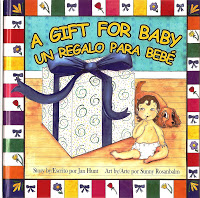
A Gift for Baby is an warm and playful look at natural parenting with an anti-consumption message. Narrative flows from the main character – an inquisitive and confident baby. Detailed illustrations combine pencils and watercolours to bring the baby’s world to life. Each page is decorated with a colourful patchwork border and displays text in both English and Spanish. The book begins with the baby discovering a giant gift-wrapped present and proceeding to guess the contents. Is it a photo? – I’d rather look at Mommy! Is it a teddy bear? – I’d rather hug Daddy! And so on. Other potential contents that baby shuns include a stroller in favour of being carried, a pacifier in favour of being comforted, a crib in favour of cosleeping, and here comes the cheeky part: “Is it a bottle?” the baby ponders. The accompanying illustration shows a thought bubble with a bottle inside. Turn the page and the baby continues, “But I like to nurse!” Here, baby is shown snuggled up to his smiling mother who nurses him upon a patchwork quilt. The climax of the book finally reveals the contents of the mystery present. Of course I’m not going to tell you. Suffice to say it is in line with the anti-consumption, ‘the best things in life are free’, message


We’re Having a Homebirth
Kelly Mochel
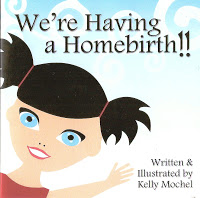
The ‘new baby’ genre is littered with hospital births so ‘We’re Having a Homebirth’ provides a welcome bucking of the trend. Witnessing the birth of a new sibling can be an exciting yet daunting experience for a young child. This honest and optimistic book prepares children for this event through a blend of factual narrative and simple yet colourful graphics. The full spectrum of childbirth sights and sounds are explained; the sight of naked Mum as she sways her hips like a belly dancer; the sound of the midwife offering words of encouragement; the sight of the blood and fluid as baby emerges; the sound of gulping as baby has his first breastfeed. Curiously the text uses anatomically correct terms in some areas (‘placenta’), yet not in others (‘boobies’). This dichotomy between non-apologetically factual details on one hand, and yet toned-down sanitised details on the other, is present throughout the book. For instance, the placenta is shown, complete with cord, and Mum has pubic hair, both of which are excellent on the realism front. However I was disappointed that the baby itself was not covered with blood and fluid, as this is an important part of preparing children for the reality of the childbirth scene. Nevertheless this book remains a brave attempt at exploring unchartered waters in children’s literacy. What’s more, its child-friendly size and light weight make it perfect for a midwife or doula to keep in their handbag, ready for home visits.
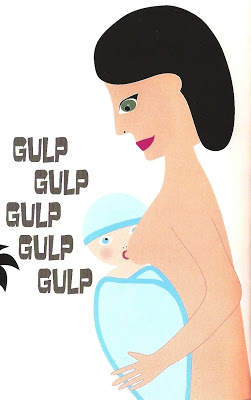
Coming up: Images of Breastfeeding in Children’s Books, Part Seven




























